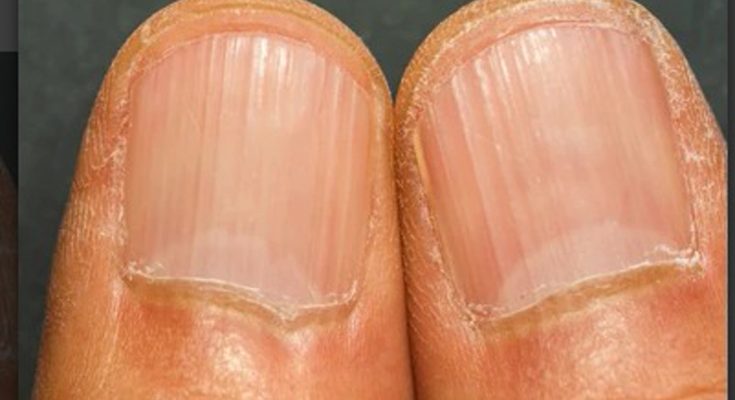
What Stripes on Your Nails Could Be Telling You About Your Health
Our nails do more than complete our look — they can reflect what’s going on inside our bodies. Though they’re made mostly of keratin (the same protein found in hair), nails are sensitive to nutritional imbalances, systemic illnesses, and physical stress. One particularly telling sign? Stripes or lines that appear on the surface of the nail.
These marks—whether vertical ridges, horizontal grooves, or pigmented streaks—might seem cosmetic at first, but they can reveal more than you think. Let’s break down the types of nail stripes, what causes them, and when you should pay closer attention.
Types of Nail Stripes
Nail stripes come in various forms, and understanding which kind you have is key to figuring out what they might mean:
-
Vertical Ridges (Longitudinal Lines): Thin lines running from the cuticle to the tip. These are usually harmless and tend to show up more with age.
-
Horizontal Ridges (Beau’s Lines): Indentations or grooves stretching across the nail. These often suggest a temporary halt in nail growth, usually due to illness or stress.
-
Pigmented Stripes: These can be white, brown, or black and may appear as one line or multiple bands.
-
Muehrcke’s Lines: White, paired bands that stay in place even as the nail grows. These often signal internal health problems.
Why Striped Nails Happen
There are several reasons why nail stripes might appear — ranging from everyday changes to serious medical conditions:
1. Aging
As we age, it’s normal to see vertical ridges on our nails. They’re usually a result of slower cell turnover and reduced moisture, and they’re rarely a cause for concern.
2. Nutrient Deficiencies
Lack of essential nutrients can directly affect nail growth and appearance:
-
Iron deficiency may cause spoon-shaped nails and visible ridges.
-
Zinc deficiency can lead to white lines or spots.
-
Protein deficiency is often linked to Muehrcke’s lines.
A balanced, nutrient-rich diet is one of the best defenses against nail changes.
3. Injury or Physical Stress
If you’ve recently slammed a finger or undergone surgery, you might develop horizontal lines like Beau’s lines. These are usually temporary and fade as the nail grows out.
4. Underlying Health Conditions
Some health problems show early warning signs through nail changes:
-
Kidney Disease: Can cause Muehrcke’s lines or a “half-and-half” nail appearance.
-
Liver Disease: May produce white nails with red or pink streaks.
-
Heart Issues: Splinter-like dark lines may hint at heart infections or vascular issues.
5. Fungal Infections
Fungal nail infections can cause discoloration, usually yellow or brown stripes, and thickened nail beds. These typically require antifungal treatment.
6. Melanonychia
This condition involves dark brown or black bands on the nail. While melanonychia can be harmless (especially in people with darker skin), it can also signal melanoma, the deadliest form of skin cancer. Rapidly changing or new dark streaks warrant an urgent dermatology visit.
7. Medication Side Effects
Drugs, particularly chemotherapy agents, may alter nail texture and color. These changes are usually temporary and resolve after treatment ends.
Getting a Diagnosis
If something looks off about your nails, don’t ignore it. Healthcare professionals will typically use the following steps to investigate:
-
Medical History: To understand any underlying conditions, recent illness, or medications.
-
Visual Exam: Nails are inspected for color, shape, and stripe patterns.
-
Lab Testing: Blood work may reveal nutritional gaps or chronic diseases.
-
Biopsy: For suspicious pigment changes, particularly in cases of melanonychia.
Can You Prevent Striped Nails?
While not all causes are preventable, some simple steps can help keep your nails healthy and minimize the risk of changes:
-
Eat a Well-Balanced Diet: Get enough iron, zinc, protein, and biotin.
-
Practice Good Nail Hygiene: Keep nails trimmed, clean, and moisturized.
-
Avoid Physical Damage: Don’t bite or pick at your nails. Use gloves when working with harsh chemicals.
-
Monitor New Medications: Report any nail changes to your doctor promptly.
-
Schedule Routine Checkups: Your doctor may spot health issues before you do.
When Should You Worry?
Although many nail changes are benign, it’s time to call your doctor if:
-
Stripes appear suddenly without any clear reason.
-
Dark streaks are growing, spreading, or painful.
-
Other symptoms like fatigue, weight loss, or skin changes accompany the nail issue.
Final Thoughts
Your nails might seem like a small detail, but they can offer big insights into your health. Not all stripes or lines are cause for alarm, but they shouldn’t be ignored either. Whether it’s a nutrient imbalance, a sign of aging, or a red flag for something more serious, paying attention to your nails can help you catch potential problems early.
When in doubt, speak with a healthcare provider. Because sometimes, what’s happening on the surface is just the beginning of the story.
Cade Cunningham leads Pistons to first playoff win in 17 years, avoiding another late-game collapse vs. Knicks
In Game 2 of their first-round series, the Pistons showed that they’d learned a lesson from the opener

Imagn Images
NEW YORK — Before Game 2 of the Detroit Pistons‘ first-round series against the New York Knicks at Madison Square Garden on Monday, coach J.B. Bickerstaff offered his perspective on teaching his young team about playoff basketball: You can tell players how it’s different from the regular season but they still have to feel it for themselves.
“We showed guys film, had a conversation and all those things,” Bickerstaff said, “but I always make this analogy: I tell my kids stuff all the time, and they look at me like I’m crazy. Then they go out and do the dumb stuff that I told them not to do, and then they realize, ‘Oh, shit, that was dumb.’ It’s similar to that.”
The Pistons did no shortage of dumb stuff in the fourth quarter of their series-opening loss on Saturday, but Monday’s game afforded them a chance to show what they’d learned. Once again, they had an eight-point lead heading into the final frame. Once again, the Knicks made a push and got the crowd into it.
This time, though, there was no 21-0 run.
When the Knicks cut their deficit to four points with less than five minutes left, Cade Cunningham got downhill, got to the line and made both free throws. When New York tied it in crunch time, Dennis Schroder calmly cashed a pull-up 3. The Pistons pulled out a 100-94 victory, giving them home-court advantage as the series, now tied 1-1, shifts to Detroit.
“Last game, fourth quarter hit, we folded, kind of,” Pistons big man Paul Reed said. “This game, we took care of business.”
It was a mature, professional performance. It was also Detroit’s first postseason victory win in 17 years, ending a 15-game losing streak.
“It feels good to represent the city like we did tonight,” Cunningham said. “It’s something that the city has been waiting on for a long time, so we feel good about it and we’re ready to get back to the crib and perform in front of them.”
No Pistons player was more responsible for the way they responded than Cunningham. The 23-year-old face of the franchise didn’t play badly in Game 1, but he definitely didn’t dominate and he committed three turnovers during his team’s fourth-quarter meltdown. In Game 2, Cunningham “had his mind made up what he was going out to do,” Bickerstaff said. He finished with 33 points on 11-for-21 shooting with 12 rebounds and three assists in 42 minutes.
Cunningham pushed the ball at every opportunity. In the halfcourt, he manipulated matchups and put pressure on the rim, looking comfortable, confident and in control.
“He was awesome,” Detroit forward Tobias Harris said. “He was attacking, he was fast, he was decisive. He made the right play time and time again on the floor, and I thought he was spectacular.”
In his second playoff game, he had his first signature playoff moment.
“He did exactly what I expect him to do all the time, which is go out there and kill anything in front of him, get his teammates open and be a great leader,” Reed said.
Leading up to Game 2, Cunningham said he got as much treatment as he could. He watched some film of what had gone wrong, “but, at the end of the day, I trust our system, I trust the guys,” he said. “We knew that we dropped that game, so it was just about coming out today and being aggressive and trying to out-dog ’em.”
The Pistons shot terribly — they went 6 for 27 from deep as a team, and guards Malik Beasley and Tim Hardaway Jr. went a combined 1 for 14 — but they consistently put the Knicks in compromising positions defensively. They attempted 34 free throws, and limited star big man Karl-Anthony Towns to 10 points and zero free-throw attempts.
“Tobias did a phenomenal job of just being physical with [Towns], not letting him get to his spot, making him take tough 2s over the top of him,” Bickerstaff said. “We eliminated a lot of the catch and shoot 3s that he’d been getting throughout the season.”

A blowout would have been nice, but there’s something to be said for gutting out a win in a hostile environment, especially considering what had happened two days prior.
“Honestly, for ourselves, we wanted to send a message,” Harris said.
Detroit was disappointed after Game 1, but it wasn’t dispirited.
“All of this for us is learning,” Bickerstaff said. “These moments for us, as a group, myself, as a staff, with this team, we haven’t done this before, so any test, any challenge that’s put in front of us is a great test and a great challenge for us.”
Bickerstaff, a Coach of the Year candidate who took over a team that had won 14 games last season and guided them to 44 this season, called these Pistons a “special group” because “they don’t want to let each other down.” Reed didn’t play a second in Game 1, but was thrust into the rotation because of Isaiah Stewart’s knee injury. Game 2 was “a testament to how together we are, how locked in everybody is,” big man Jalen Duren said. “We’re a team.”
Asked about the significance of the franchise’s first playoff win since 2008, Bickerstaff said he’d talk about it in the summer, as the team is focused on the present moment. The players mostly followed suit. As he scrolled through his phone at his locker, through, guard Ausar Thompson said, “Damn, broke a 15-game playoff losing streak.”
“We got three more wins we got to go get, so it’s like there’s no point in getting too happy right now,” Reed said. “Maybe once the series is over, then we can be more excited. But we’re definitely excited. Don’t let us trying to keep a straight face — don’t let that fool you. We’re excited. But we know we gotta keep our composure.”
